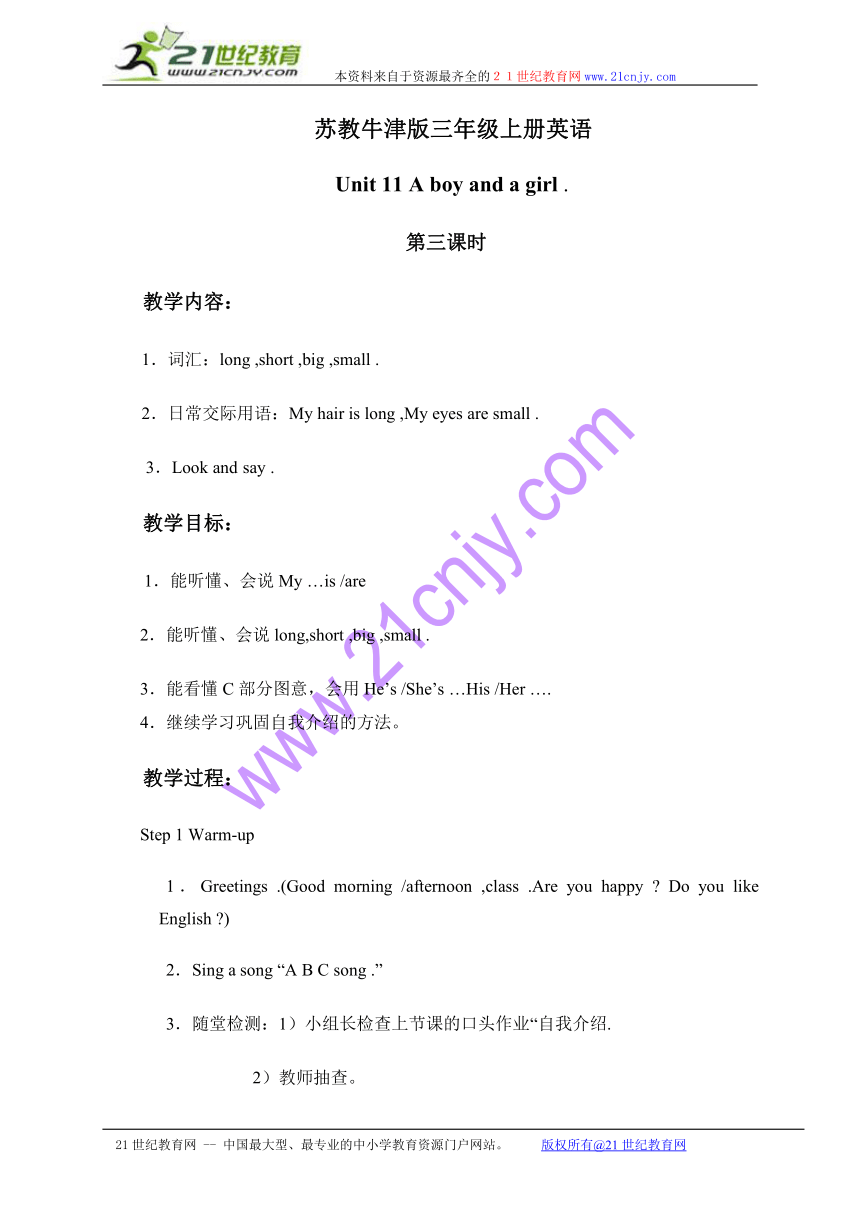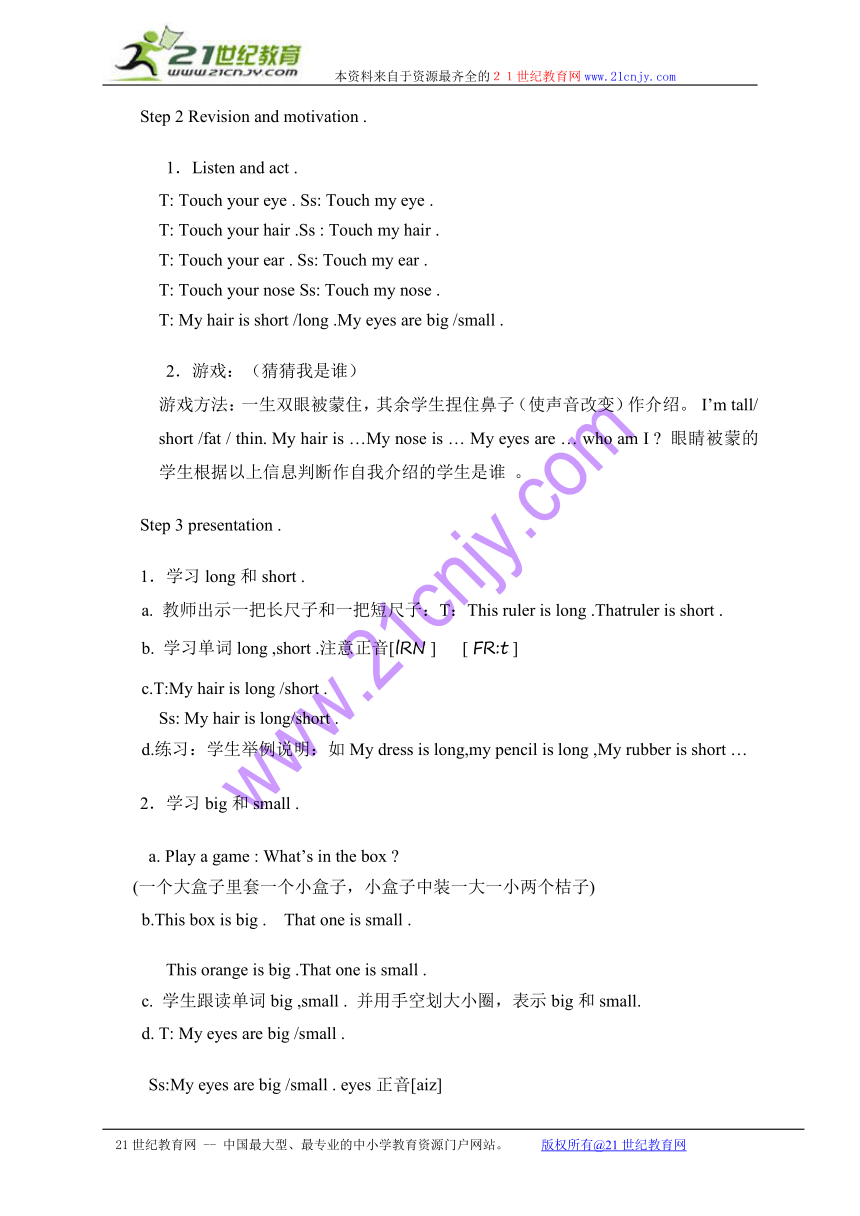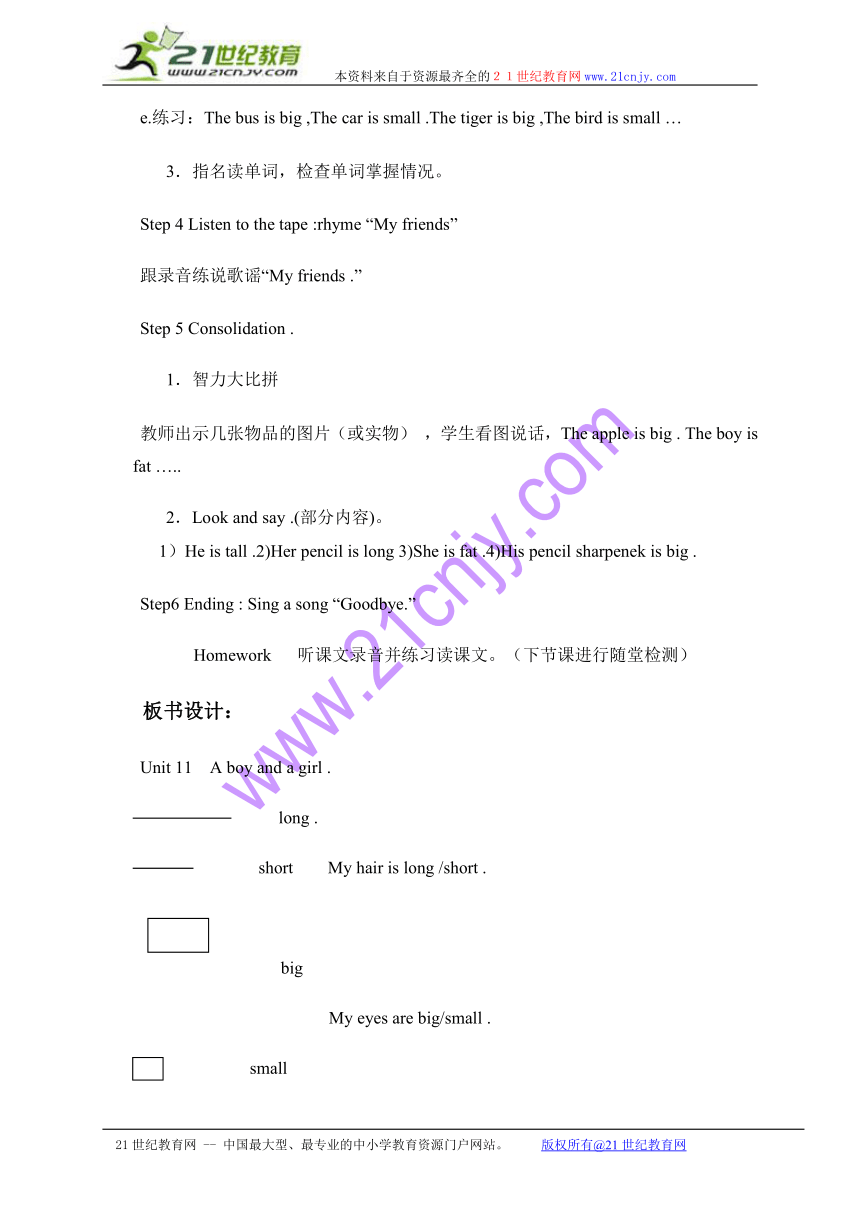三年级英语上册教案 unit 11 第3-4课时(苏教牛津版)
文档属性
| 名称 | 三年级英语上册教案 unit 11 第3-4课时(苏教牛津版) |  | |
| 格式 | rar | ||
| 文件大小 | 15.2KB | ||
| 资源类型 | 教案 | ||
| 版本资源 | 牛津苏教版 | ||
| 科目 | 英语 | ||
| 更新时间 | 2009-10-28 20:26:00 | ||
图片预览



文档简介
本资料来自于资源最齐全的21世纪教育网www.21cnjy.com
苏教牛津版三年级上册英语
Unit 11 A boy and a girl .
第三课时
教学内容:
1.词汇:long ,short ,big ,small .
2.日常交际用语:My hair is long ,My eyes are small .
3.Look and say .
教学目标:
1.能听懂、会说My …is /are
2.能听懂、会说long,short ,big ,small .
3.能看懂C部分图意,会用He’s /She’s …His /Her ….
4.继续学习巩固自我介绍的方法。
教学过程:
Step 1 Warm-up
1.Greetings .(Good morning /afternoon ,class .Are you happy Do you like English )
2.Sing a song “A B C song .”
3.随堂检测:1)小组长检查上节课的口头作业“自我介绍.
2)教师抽查。
Step 2 Revision and motivation .
1.Listen and act .
T: Touch your eye . Ss: Touch my eye .
T: Touch your hair .Ss : Touch my hair .
T: Touch your ear . Ss: Touch my ear .
T: Touch your nose Ss: Touch my nose .
T: My hair is short /long .My eyes are big /small .
2.游戏:(猜猜我是谁)
游戏方法:一生双眼被蒙住,其余学生捏住鼻子(使声音改变)作介绍。 I’m tall/ short /fat / thin. My hair is …My nose is … My eyes are … who am I 眼睛被蒙的学生根据以上信息判断作自我介绍的学生是谁 。
Step 3 presentation .
1.学习long和short .
a. 教师出示一把长尺子和一把短尺子:T:This ruler is long .Thatruler is short .
b. 学习单词long ,short .注意正音[ ] [ ]
c.T:My hair is long /short .
Ss: My hair is long/short .
d.练习:学生举例说明:如My dress is long,my pencil is long ,My rubber is short …
2.学习big和small .
a. Play a game : What’s in the box
(一个大盒子里套一个小盒子,小盒子中装一大一小两个桔子)
b.This box is big . That one is small .
This orange is big .That one is small .
c. 学生跟读单词big ,small . 并用手空划大小圈,表示big和small.
d. T: My eyes are big /small .
Ss:My eyes are big /small . eyes正音[aiz]
e.练习:The bus is big ,The car is small .The tiger is big ,The bird is small …
3.指名读单词,检查单词掌握情况。
Step 4 Listen to the tape :rhyme “My friends”
跟录音练说歌谣“My friends .”
Step 5 Consolidation .
1.智力大比拼
教师出示几张物品的图片(或实物) ,学生看图说话,The apple is big . The boy is fat …..
2.Look and say .(部分内容)。
1)He is tall .2)Her pencil is long 3)She is fat .4)His pencil sharpenek is big .
Step6 Ending : Sing a song “Goodbye.”
Homework 听课文录音并练习读课文。(下节课进行随堂检测)
板书设计:
Unit 11 A boy and a girl .
long .
short My hair is long /short .
big
My eyes are big/small .
small
第四课时
教学内容:
1.Fun house .
2.完成练习册。
教学目标:
1.进行听力训练。
2.继续训练学生自我介绍的方法。
教学进程:
Step 1 Warm-up .
1.随堂检测: 上节课布置的口头作业读课文。1)小组长检查。 2)抽查。
2.Sing a song : Colour song .
3.Say a rhyme :My friends .
4.Pass the pictures and read the words .man ,woman ,boy ,girl ,fat ,thin, big ,small ,long ,short ,eye ,hair ,tall,short .
Step 2 Review .
竞赛: 插红旗。比赛方法: 每组派一名学生到板前排列词卡(本课的八个形容词)每两个意思相反的词放在同一个圆圈内,最先排好的,且无误的一组可以得到一面小红旗。
Step 3 Presentation : D Fun house .
1.Listen and act .
T: Open your book .Close your eyes .
Turn on the light .Turn off the light .
Put up your hands .Put down your hands .
2.Listen to the tape and number .(D Fun house ).
a. 先看四幅图:T:what can you see
S: I can see …
b. 听录音编号:
c. 对答案:a 2 ,5 b 3 ,7 c 1 ,6 d 4 ,8.
3.Listen and guess .(教师编谜语学生猜)
如:a. I’m very fat and big ,My nose is long ,Who am I
b. I’m white ,My ears are long ,My tail is short ,My eyes are red ,Who am I (兔子)
c. I’m very thin ,My tail is long ,Ican climb .Who am I ( Monkey )
4.Say a rhyme : My friends .
Step 4 Do the workbook .
1.Listen and respond .
a. Free talk . (复习Unit 7 ---Unit 11的对话)
b.播放练习录音,学生抢答。
2.Listen and draw .
a. 听音贴图片:a zebra ,a tiger ,a bird , an elephant .
b. 游戏:Listen and point .
c. 听录音,连线。
3.Listen ,find and draw .
a. 猜猜。
师出示图片,遮住部分画面,生猜猜是什么
a short skirt a new fridge a tall man an egg .
b. 听录音画画。
4.Listen and match .
a. 出示人物图片(或衣服图片),全用This is …作介绍。
b. 听录音连线。
5.Listen ,find and circle .
a. 看图,说说你看到了什么。
b. 师总结关键词。
c. 听录音画圈。
板书设计:
Unit 11 A boy and girl .
My name is …
I’m a Chinese boy /girl .
I’m from …
I’m ten .
I’m …
My …is /are …
教学后记:
1. 本单元教学设计了丰富多彩的活动与竞赛,学生参与的热情很高,在活动中,学生感到放松,心情愉快,我发现一些平时害羞的小孩受到周围同学情绪的感染,也稍微大胆了一些,克服了以前羞于开口的困难。
2. 八个形容词big ,small, fat , thin , long , short ,tall ,short .在一定的情景中学习,并利用不同的手势比划出来,学生的印象对此比较深刻。这四组反义词的应用应该说还是蛮熟练的,可是在本课C Look and say看图表达能力欠佳。他们不能把图画的内容、意思和所学的句型有机地联系在一起,在老师做了示范以后,他们方能交际,可以看出,他们的依赖性很强,学习上缺乏自主性。如何培养他们学习上的独立性呢?
3. 本课比较注意降低学习难度,培养学生的“成就感”,这主要源于苏霍姆林斯基说的“成功的欢乐是一种巨大的情绪,力量。它可促进儿童好好学习的愿望。”在实际的教学中,我注意及时有效地获得教学信息反馈,因材施教,在授课过程中,我一边认真上课,一边仔细观察学生的神态变化,以控制和调节教学活动。如提问把难题留给优生,容易的留给中下等学生,帮助中下等生树立学习外语的“心理优势”,使不同层次的学生都能享受到成功的喜悦。
21世纪教育网 -- 中国最大型、最专业的中小学教育资源门户网站。 版权所有@21世纪教育网
苏教牛津版三年级上册英语
Unit 11 A boy and a girl .
第三课时
教学内容:
1.词汇:long ,short ,big ,small .
2.日常交际用语:My hair is long ,My eyes are small .
3.Look and say .
教学目标:
1.能听懂、会说My …is /are
2.能听懂、会说long,short ,big ,small .
3.能看懂C部分图意,会用He’s /She’s …His /Her ….
4.继续学习巩固自我介绍的方法。
教学过程:
Step 1 Warm-up
1.Greetings .(Good morning /afternoon ,class .Are you happy Do you like English )
2.Sing a song “A B C song .”
3.随堂检测:1)小组长检查上节课的口头作业“自我介绍.
2)教师抽查。
Step 2 Revision and motivation .
1.Listen and act .
T: Touch your eye . Ss: Touch my eye .
T: Touch your hair .Ss : Touch my hair .
T: Touch your ear . Ss: Touch my ear .
T: Touch your nose Ss: Touch my nose .
T: My hair is short /long .My eyes are big /small .
2.游戏:(猜猜我是谁)
游戏方法:一生双眼被蒙住,其余学生捏住鼻子(使声音改变)作介绍。 I’m tall/ short /fat / thin. My hair is …My nose is … My eyes are … who am I 眼睛被蒙的学生根据以上信息判断作自我介绍的学生是谁 。
Step 3 presentation .
1.学习long和short .
a. 教师出示一把长尺子和一把短尺子:T:This ruler is long .Thatruler is short .
b. 学习单词long ,short .注意正音[ ] [ ]
c.T:My hair is long /short .
Ss: My hair is long/short .
d.练习:学生举例说明:如My dress is long,my pencil is long ,My rubber is short …
2.学习big和small .
a. Play a game : What’s in the box
(一个大盒子里套一个小盒子,小盒子中装一大一小两个桔子)
b.This box is big . That one is small .
This orange is big .That one is small .
c. 学生跟读单词big ,small . 并用手空划大小圈,表示big和small.
d. T: My eyes are big /small .
Ss:My eyes are big /small . eyes正音[aiz]
e.练习:The bus is big ,The car is small .The tiger is big ,The bird is small …
3.指名读单词,检查单词掌握情况。
Step 4 Listen to the tape :rhyme “My friends”
跟录音练说歌谣“My friends .”
Step 5 Consolidation .
1.智力大比拼
教师出示几张物品的图片(或实物) ,学生看图说话,The apple is big . The boy is fat …..
2.Look and say .(部分内容)。
1)He is tall .2)Her pencil is long 3)She is fat .4)His pencil sharpenek is big .
Step6 Ending : Sing a song “Goodbye.”
Homework 听课文录音并练习读课文。(下节课进行随堂检测)
板书设计:
Unit 11 A boy and a girl .
long .
short My hair is long /short .
big
My eyes are big/small .
small
第四课时
教学内容:
1.Fun house .
2.完成练习册。
教学目标:
1.进行听力训练。
2.继续训练学生自我介绍的方法。
教学进程:
Step 1 Warm-up .
1.随堂检测: 上节课布置的口头作业读课文。1)小组长检查。 2)抽查。
2.Sing a song : Colour song .
3.Say a rhyme :My friends .
4.Pass the pictures and read the words .man ,woman ,boy ,girl ,fat ,thin, big ,small ,long ,short ,eye ,hair ,tall,short .
Step 2 Review .
竞赛: 插红旗。比赛方法: 每组派一名学生到板前排列词卡(本课的八个形容词)每两个意思相反的词放在同一个圆圈内,最先排好的,且无误的一组可以得到一面小红旗。
Step 3 Presentation : D Fun house .
1.Listen and act .
T: Open your book .Close your eyes .
Turn on the light .Turn off the light .
Put up your hands .Put down your hands .
2.Listen to the tape and number .(D Fun house ).
a. 先看四幅图:T:what can you see
S: I can see …
b. 听录音编号:
c. 对答案:a 2 ,5 b 3 ,7 c 1 ,6 d 4 ,8.
3.Listen and guess .(教师编谜语学生猜)
如:a. I’m very fat and big ,My nose is long ,Who am I
b. I’m white ,My ears are long ,My tail is short ,My eyes are red ,Who am I (兔子)
c. I’m very thin ,My tail is long ,Ican climb .Who am I ( Monkey )
4.Say a rhyme : My friends .
Step 4 Do the workbook .
1.Listen and respond .
a. Free talk . (复习Unit 7 ---Unit 11的对话)
b.播放练习录音,学生抢答。
2.Listen and draw .
a. 听音贴图片:a zebra ,a tiger ,a bird , an elephant .
b. 游戏:Listen and point .
c. 听录音,连线。
3.Listen ,find and draw .
a. 猜猜。
师出示图片,遮住部分画面,生猜猜是什么
a short skirt a new fridge a tall man an egg .
b. 听录音画画。
4.Listen and match .
a. 出示人物图片(或衣服图片),全用This is …作介绍。
b. 听录音连线。
5.Listen ,find and circle .
a. 看图,说说你看到了什么。
b. 师总结关键词。
c. 听录音画圈。
板书设计:
Unit 11 A boy and girl .
My name is …
I’m a Chinese boy /girl .
I’m from …
I’m ten .
I’m …
My …is /are …
教学后记:
1. 本单元教学设计了丰富多彩的活动与竞赛,学生参与的热情很高,在活动中,学生感到放松,心情愉快,我发现一些平时害羞的小孩受到周围同学情绪的感染,也稍微大胆了一些,克服了以前羞于开口的困难。
2. 八个形容词big ,small, fat , thin , long , short ,tall ,short .在一定的情景中学习,并利用不同的手势比划出来,学生的印象对此比较深刻。这四组反义词的应用应该说还是蛮熟练的,可是在本课C Look and say看图表达能力欠佳。他们不能把图画的内容、意思和所学的句型有机地联系在一起,在老师做了示范以后,他们方能交际,可以看出,他们的依赖性很强,学习上缺乏自主性。如何培养他们学习上的独立性呢?
3. 本课比较注意降低学习难度,培养学生的“成就感”,这主要源于苏霍姆林斯基说的“成功的欢乐是一种巨大的情绪,力量。它可促进儿童好好学习的愿望。”在实际的教学中,我注意及时有效地获得教学信息反馈,因材施教,在授课过程中,我一边认真上课,一边仔细观察学生的神态变化,以控制和调节教学活动。如提问把难题留给优生,容易的留给中下等学生,帮助中下等生树立学习外语的“心理优势”,使不同层次的学生都能享受到成功的喜悦。
21世纪教育网 -- 中国最大型、最专业的中小学教育资源门户网站。 版权所有@21世纪教育网
